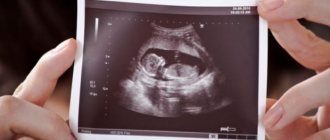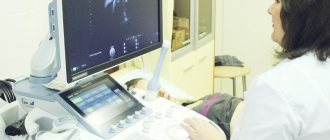At the moment, ultrasound helps to assess the condition of the fetus, its development and early detection of pathology. Ultrasound is becoming a mandatory procedure for pregnant women. You should not draw conclusions on your own based on the ultrasound results - this should be done by your obstetrician-gynecologist. Of course, you will decide on further management tactics with your doctor. He will offer you all possible options, and of course the decision will be made by the couple. A woman should not take the decision on herself and decide for herself what to do. This is a family issue.
Target
An ultrasound scan at 6 obstetric weeks corresponds to the age of the embryo at 4 weeks. The embryo is still very small, so it is still impossible to identify anomalies and features of its development using ultrasound diagnostics. At the same time, during this period, the processes of laying down organs and systems take place, and cells are dividing intensively. Therefore, it is undesirable to interfere with the development process of the embryo without reason. Although ultrasound has not been proven to be harmful, it is better to wait until after your first screening.
However, in some situations, performing an ultrasound at 6 weeks is necessary. The goals of ultrasound diagnostics during this period are:
- confirmation of pregnancy;
- establishing the age of the embryo;
- determining the number of fetuses in the uterus;
- embryo viability assessment;
- diagnosis of ectopic pregnancy;
- identifying signs of impending miscarriage;
- detection of pathology and characteristics of the mother’s reproductive organs.
What will the diagnostics show?
When conducting early pregnancy research, many mothers think that an ultrasound will help them find out the sex of the child. But that's not true.
The doctor will pay attention to:
- possible pathologies in fetal development;
- the fetus may already have a heartbeat;
- embryo imaging;
- the presence of one or more fertile eggs in the uterus;
- the exact location of the fertilized egg in the uterus.
Looking at the monitor, the expectant mother will see her baby. It will resemble a pea or a small dark spot. In this case, you can consider the legs and arms. The baby's eyes are poorly developed at this stage of pregnancy, for this reason they will be tightly closed.
The specialist will study the fetus, its internal organs, and will also help eliminate possible defects in the functioning of the heart, liver and other organs.
And at this time, a happy mother can find out that she is expecting twins.
What does it represent?
Ultrasound in the sixth week of pregnancy is performed in most cases transvaginally. A woman, lying on her back with her knees bent, has a sensor inserted into her vagina. There is no need to be afraid of transmitting infections this way, since a condom is placed on the sensor. It is recommended that a pregnant woman 2-3 days before an ultrasound examination avoid eating foods that cause increased gas formation in the intestines (legumes, baked goods, raw vegetables and fruits, etc.). Immediately before the ultrasound procedure, the bladder must be emptied.
If it is impossible to conduct a transvaginal examination, transabdominal ultrasound is used. In this case, a sensor using a special gel is moved over the abdomen. A couple of days before the examination, it is necessary to follow a diet in order to prevent increased accumulation of gases in the intestines. This may interfere with the ultrasound examination and produce a blurry image. 30-60 minutes before the ultrasound, you need to drink 1-1.5 liters of water until the average desire to urinate arises.
How is an ultrasound performed at 6 weeks of pregnancy?
There are two options for how doctors do an ultrasound in the 6th week of pregnancy:
- The transvaginal method
is the insertion of a vaginal ultrasound sensor protected by a special condom into the vaginal cavity of a pregnant woman. - Transabdominal method
- through the skin of the abdomen. Before the scan, women apply a special gel to their abdomen.
The first method may cause some discomfort to the woman, but its results will be more accurate and complete. Contraindications to transvaginal ultrasound for a pregnant woman may include bleeding or abdominal pain.
What can you see
At 6 weeks of gestation, an ultrasound examination reveals a fertilized egg against the background of a thickened hyperechoic endometrium. It is a round or oval anechoic formation with a hyperechoic rim. The internal diameter of the fetal egg at this stage is about 22 millimeters. Starting from 5 weeks of pregnancy, its size increases by 1-2 mm. If its size does not correspond to the expected obstetric period, a control ultrasound examination is performed after 3-5 days.
The embryo and yolk sac should already be visualized in the fertilized egg. Positioned eccentrically, they form an image on the monitor in the form of a double bubble. The yolk sac is defined as a round, thin-walled formation with anechoic contents inside. Its normal size is 3-5 mm in diameter. The function of this formation is to nourish the embryo until the placenta is formed, which will take care of it. The absence of a yolk sac or its increase by more than 6 mm may indicate a non-developing pregnancy.
The embryo is identified 3 weeks after conception. At the sixth week it looks like a tadpole. Although many organs are already being formed, it is not possible to identify defects and anomalies in the development of the embryo. The main and so far only measured size of the fetus is the coccyx-parietal size. At 6 weeks it is 6 millimeters. CTE is equal to the length of the embryo from the head to the coccyx. Based on its value, the gestational age and possible date of birth are determined.
In one of the ovaries, a corpus luteum is found at the site of the released egg. Its size is on average 16-20 mm. When performing Doppler measurements, increased blood flow in it is recorded. The corpus luteum produces progesterone, which helps maintain pregnancy. As the placenta forms and grows, the placenta takes over the function of producing this hormone, and the corpus luteum dissolves.
What does the examination show?
Visualization of the fetus in the first weeks of pregnancy is difficult. During the examination, the doctor discovers the embryo and yolk sac. Two subtle shadows are visible on the screen. It is impossible to examine individual parts of the future person at this time.
One of the most important characteristics is the size of the embryo. On an ultrasound scan at 6 weeks of pregnancy, the size of the ovum is 25 mm, and the weight does not exceed 1 gram.
To assess development, it is necessary to determine the heartbeat. Normal heart rate at 6 weeks is between 110 and 150 beats per minute. A significant decrease in heart rate indicates a serious condition of the embryo and requires urgent correction.
To detect intrauterine infections, the volume of amniotic fluid is measured. During this period it ranges from 2.5 to 3 ml. A change in this parameter indicates a pathology of pregnancy.
Also, during the study, multiple pregnancies can be detected. On an ultrasound, twins or twins are visible as early as 5-6 weeks. On the monitor you can see 2 hypoechoic (dark) heterogeneous formations, inside of which there are clearings (embryos).
To see what a singleton pregnancy at this stage looks like on an ultrasound:
Possible pathologies
During an ultrasound examination, the following pathologies can be detected: a small fetal egg, frozen pregnancy, absence of an embryo in the uterus, ectopic localization of the fetal egg, retrochorial hematoma.
- The small size of the fertilized egg can be either a type of normal or a sign of a serious disorder. In the first case, the discrepancy between the size of the fertilized egg and the gestation period may indicate late implantation or an incorrectly determined gestational age. At the same time, no other pathologies on the part of the fetus or mother are observed.
- If, in addition to low growth rates, a decrease in heart rate is observed, it is worth suspecting a frozen pregnancy, which leads to the inevitable death of the fetus. In such a situation, it is necessary to promptly remove the dead embryo from the uterine cavity. Otherwise, the risk of infectious complications is high.
- Among other pathologies, anembryonia (absence of an embryo) is common. The causes of this condition may be infections, endocrine disorders, and genetic abnormalities. In this case, only the fertilized egg is visible on ultrasound (the embryo is not visualized).
- An ectopic pregnancy is characterized by the location of the fertilized egg outside the uterine cavity. This condition is considered life-threatening, so the woman is hospitalized for examination and determination of management tactics.
- Retrochorial hematoma is the site of detachment of the fertilized egg from the uterine wall. The cause of this condition may be severe physical and emotional stress, infectious diseases and the use of certain medications. In this case, the woman feels nagging pain in the lower abdomen, which is often accompanied by bloody discharge. Ultrasound reveals a hypoechoic formation between the uterine wall and the fertilized egg. In this case, the prognosis depends on the size of the hematoma. With minor detachment, pregnancy and delivery may be maintained.
Video of an ectopic pregnancy:
An ultrasound examination at 6 weeks of pregnancy helps diagnose pathologies on the part of the mother or fetus. Early detection of diseases improves the prognosis and course of pregnancy.
If you had an ultrasound at 6 weeks pregnant, please share your experience with others. Repost. Be healthy.
Diagnosis of ectopic pregnancy
One of the indications for an ultrasound examination at 6 weeks of pregnancy is a suspicion of an ectopic location of the ovum. Such a diagnosis is often made precisely at this time. A fertilized egg can be found in one of the fallopian tubes, in the cervical canal, or in the abdominal cavity.
If a question arises about the duration of pregnancy, the level of human chorionic gonadotropin can be determined. When its value is 1500 units/ml or more, the fertilized egg should be detected in the uterus. If this does not happen, then they speak of an ectopic pregnancy. When performing an ultrasound, it should be taken into account that if the embryo is ectopically located in the center of the uterus, a false fertilized egg may be visualized. It is an anechoic formation of round or irregular shape with a diameter of up to 10 mm. It is formed from decidually changed endometrium.
If fluid is detected in the pelvis, it is necessary to exclude a disturbed intrauterine pregnancy with the development of intra-abdominal bleeding.
Ultrasound at the 6th obstetric week of pregnancy
The 6th obstetric week of pregnancy is the time when the fetus can be seen quite clearly on an ultrasound. As prescribed by the attending physician, a woman can undergo this procedure at this time to determine a further pregnancy management strategy.
Why is an ultrasound scan necessary at 6 weeks of pregnancy?
The timing of mandatory ultrasound is established by the Ministry of Health of the Russian Federation. For the 1st trimester it is 10-13 weeks, for the 2nd – 20-24, for the 3rd – 32-34 weeks. But there are cases when ultrasound diagnostics can be performed earlier:
- the woman has already had miscarriages or missed pregnancies;
- fertilization was performed in vitro (IVF);
- previous pregnancies ended in a cesarean section (that is, a scar was left on the uterus, and it is important to see how close the chorion is attached to it).
An ultrasound is performed to first confirm the fact of pregnancy, then assess where the fertilized egg is attached (in the uterus or outside it), then assess its size and identify existing threats to pregnancy.
What do they look for on an ultrasound?
Performing an ultrasound in the sixth week of pregnancy
, the doctor will first look to see if the fertilized egg is visualized in the uterus. Next, you need to evaluate its size and see if there is a living embryo in the egg.
Also, with the help of ultrasound, you need to see how the fetal heart is formed and at what frequency it beats.
It is important to look at the condition of the organs of the reproductive system of the expectant mother. In particular, evaluate the length of the cervix, since a cervix that is too short can cause miscarriage or premature birth.
In the sixth week, the endometrium is also examined using ultrasound, identifying its pathologies.
Non-developing pregnancy
At a period of 6 weeks, during an ultrasound examination, suspicion of a non-developing pregnancy may arise if the size of the fetal egg does not correspond to the obstetric period. In this case, a control examination is carried out to assess the dynamics of its growth after a week. The growth of the fertilized egg every day should be 1-2 mm.
When the diameter of the fertilized egg is 20 mm or more, the embryo and yolk sac should be visualized. Otherwise, they speak of anembryony. The viability of the embryo is assessed by its heartbeat. If the coccygeal-parietal size of the embryo is 6 mm or more, its heartbeat must be recorded. If it is absent, then this indicates the death of the fetus. If the heartbeat is less than 100 or more than 200 beats per minute, then this condition of the embryo is considered threatening and requires urgent treatment.
What happens to the fetus in the sixth week?
By the sixth week of pregnancy, the fetus has grown to approximately 5 mm. Now his heart makes from 140 to 160 beats per minute, that is, it beats almost twice as fast as the heart of the expectant mother. The shape of the fetus’s body already resembles a human’s; you can distinguish where its head is and where its limbs will be.
The fetal head still remains disproportionately large, but the places where the eyes, ears and mouth will be located in the future are already marked on it.
An amniotic sac has already formed, in which the baby will remain throughout the entire pregnancy until birth.
At the sixth week, the fetus begins to actively form muscles, which means it will soon be able to make its first active movements. At first, the mother will not feel them, only by about 15-16 weeks she will feel the first pleasant kicks of the baby.
This week, all internal organs of the fetus, its nervous system, and brain also continue to develop and grow.
#!UZIseredina!#
Additionally, you can identify
At a short period of gestation of the embryo, when performing ultrasound diagnostics, it is possible to identify signs of a threatened miscarriage.
This may be the detection of a subchorionic hematoma, chorionic detachment, or opening of the cervical canal of the cervix. Local uterine tone can also be detected. Ultrasound at a short period of gestation of the embryo has great informative value in diagnosing the pathology and characteristics of the woman’s genital organs. Uterine fibroids, bicornuate uterus, ovarian tumors, etc. can be detected.









